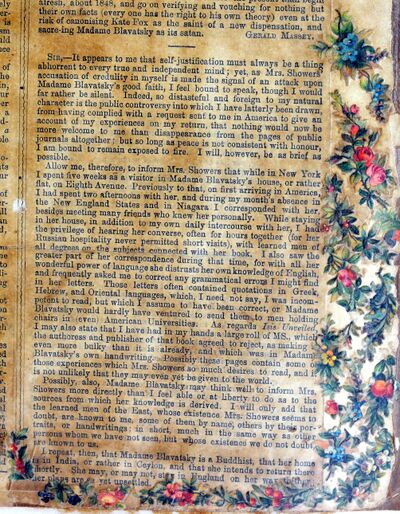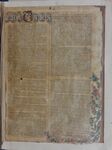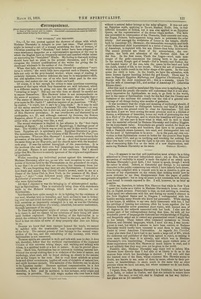
Thanks
"Isis Unveiled" and Theosophy
Sir,—I, for one, protest against the showers of abuse with which Madame Blavatsky is deluged in your last issue. That picture (it might be termed a cut) of a woman scratching the face of woman, of Christian assailing the “Heathen,” had better have been relegated to some missionary magazine as a representative specimen of the way in which the English have so frequently saluted and insulted whilst intent on converting the “benighted” Hindu. My feeling is that such writing should have had no place in the present discussion, and I fail to recognise the literary qualifications of the writer for giving the lie direct and wholesale to the author of Isis Unveiled.
When that lady, on enteringthe arena, uttered her prefatory “moriturus te Salutat,” she could little have expected such a libation, which falls not only on the grey-headed worker, whose range of reading is certainly immense, however deficient she may be in manipulative skill, but also splashes every one of us who have taken part in the controversy, and makes one rise up to shake one’s self.
Of course, it is fair enough for critics to raise questions concerning matters of fact upon which they themselves are well informed, which is a different matter to going out into the middle of the road and “swearing at large.” But any one who does so should be careful not to expose themselves. Mrs. Showers’ letter is not unimpeachable on the score of accuracy. To take but two instances; she remarks that—“The statue of Memnon may still utter its wail at sunrise.” “Might your name be Mr. Smith?” asked an inquirer of an American. “Well,” he replied, “it might, but it isn’t by a long chalk.” So it may be said of the statue erected by Amenhept III. (the Greek Memnon)—it may utter its wail at sunrise, but it does not, and is not likely to avail itself of Mrs. Showers’ permission. It was overthrown and shattered by an earthquake, B.C. 27, and although restored by Severus, the Roman Emperor, about 27 A.D., it never more responded to the rays of sunrise, either with, or anything very like, a wail.
The second statement is implied in her allusion to the “foul Osiris worship of Egypt.” As a student of Egyptology, I challenge proof of that. The worship of Osiris was as pure as any in this world has ever been. Egyptian art is spiritually pure. Egyptian literature is pure. The monuments, the ritual, the volumes of the Records of the Past[3] are my witnesses. What are Mrs. Showers’? A certain emblem borne in the procession of the spring festival! Just so. And that meant precisely the same thing as our May-pole, and the church spire with the weathercock atop. It was the natural hieroglyph of the resurrection. It is the moderns who read their own foul imaginings into the symbolism of the past. Nature is not ashamed of her emblems. But I should judge that Mrs. Showers is entirely ignorant of the origin and significance of symbolism.
Whilst recording my individual protest against this treatment of Madame Blavatsky, allow me, as one who took exception to one of the points of doctrine held by the Theosophists on the grounds of its origin, to say that I do not think they are receiving fair treatment from our side. We are forgetting that they are also Spiritualists. I remember how frank and manly was Colonel Olcott’s avowal, made to me at a dinner of the Lotus Club in New York, in the presence of Mr. Brad laugh:—“Aye!”—this followed some other remark—“and I m a Spiritualist of seventeen years’ standing.” This was not amongst people who were Spiritualists.
All that I objected to was the bringing in of misinterpreted mythology as Spiritualism. This is continually being done with statements made in the Hebrew writings, which have no relation to our Spiritualism.
Spiritualists have quite enough to do in fighting for the existence of one soul, whether here or hereafter, and have no time to lose in bickering over cut-and-dried doctrines of triplicity or duplicity, or we shall find ourselves as impotently entangled in a net as was the Christian theology, with its doctrine of a trinity, inherited, but never understood, through ignorance of its origin.
To class the physiological origin of certain myths with Spiritualism is to damn it, and we cannot be too solicitous of their being left alone until further explained. The first feeling of the Spiritualist is to clutch the evidence for our facts to be found in the past, and the likelihood is that we claim all sorts of stray property that does not belong to us
Because we know that man emerges beyond the tomb, we cannot be saddled with the unscientific and non-spiritual resurrection of the body. The natural genesis of that belongs to the annual resurrection of the sun, and the embalming of the mummy, with which Spiritualism is not concerned.
Because spirits are asserted to walk and talk with man to-day, it does not, therefore, follow that the mythical representation of the supposed Creator of this universe taking shape, and walking and talking with Adam, is a spiritual truth or a fact in nature. It can be proved otherwise. Mark this, Spiritualism has no interest in violating natural law. Science can accept nothing that is in violation of the laws of nature, and I mythology, when read, will be found sticking as closely to the natural law as the limpet to the rock. But to read those symbols as actual facts and direct occurrences, implies all sorts of violation of natural law, and myth becomes miracle. The miracles of the Hebrews can be shown to be Egyptian myths! Because spiritual communication be a fact within the sphere of natural law, the immaculate conception is not, therefore, a fact. And its mythical, in this instance, solar origin and meaning, is provable. The only virgin mother who ever bore a child without a natural father belongs to the solar allegory. It was not only an Egyptian myth, applying to Ta-urt, Hathor, Neith, Isis, in four different dynasties of deities, but it was also applied to an Egyptian Queen, as the representative of the divine virgin mother. The fable was necessited in consequence of the Pharaohs, their consorts and sons, the Repas, Princes, heirs-apparent being made to personate the solar trinity. And amongst the sculptures of Luxor in the temple, chiefly built by Amenhept III. (Memnon), the immaculate conception and birth of the miraculous child is pourtrayed in a series of scenes. Tii, the wife of Amenhept, is depicted with her son Rhuen-Aten being incarnated. The scenes pictured are those of the annunciation, the conception, the birth and adoration of the Saviour child, Son of the Sun. In the first scene, Thoth the Logos—word, male messenger of the gods—announces the coming birth to the mother. In the second, Kneph (god of breath—Nef is breath) and Hathor, the cow-headed bearer of the sun, take the queen by the hand and hold the Ankh, symbol of life, to her mouth. This is the act of incarnation, which has a visible result in the fuller shape of the queen. In the next scene the child is born. In the fourth, we have the adoration, with three human figures kneeling behind the god Kneph. These may be seen in Sharpe’s Egyptian Mythology and Egyptian Christianity, p. 19. Sharpe calls the child Amenhept III.; this is a mistake. Queen Tii was the wife of Amenhept III., and mother of Amenhept IY. (otherwiseRhuen-Aten).
After this (and it could be paralleled fifty times over in mythology, for I have collected the proofs) the reader will understand that it is not absolutely imperative for Spiritualists, as such, to go forth to the world, and in the name of Spiritualism vouch for the fact that the Creator and Sustainer of the universe did actually run the risk of a general miscarriage of all things during nine months of gestation.
It was necessary that the origin and meaning of mythology should, if possible, be ascertained to distinguish between one kind of fact and another, before the ground could be clear for Spiritualism. Till this was done, I saw we were sowing the most precious seed in a thicket of thorns, a wilderness of brambles, hence my work of pioneering the way in a Book of the Beginnings, and in which the brambles will have a bad time of it. All who care to know what is what, will do well to think over the material collected by Madame Blavatsky and Godfrey Higgins, for its iconoclastic value. Iconoclasts are greatly needed, for there are huge buildings, and rocks, and boulders, that have to be pounded, as with a Nasmyth steam-hammer, into sand, and disintegrated into soil for the seed of Spiritualism to be sown. As to the past, my own conviction is that Spiritualists cannot do better for the present than begin afresh, about 1848, and go on verifying and vouching for nothing but their own facts (every one has the right to his own theory) even at the risk of canonising Kate Fox as the saint of a new dispensation, and secreting Madame Blavatsky as its satan.
<Untitled> (Sir,-It appears to me that self-justification...)
Sir,—It appears to me that self-justification must always be a thing abhorrent to every true and independent mind; yet, as Mrs. Showers’ accusation of credulity in myself is made the signal of an attack upon Madame Blavatsky’s good faith, I feel bound to speak, though I would far rather be silent. Indeed, so distasteful and foreign to my natural character is the public controversy into which I have latterly been drawn, from having complied with a request sent to me in America to give an account of my experiences on my return, that nothing would now be more welcome to me than disappearance from the pages of public journals altogether; but so long as peace is not consistent with honour, I am bound to remain exposed to fire. I will, however, be as brief as possible.
Allow me, therefore, to inform Mrs. Showers that while in New York I spent five weeks as a visitor in Madame Blavatsky’s house, or rather flat, on Eighth Avenue. Previously to that, on first arriving in America, I had spent two afternoons with her, and during my month’s absence in the New England States and in Niagara I corresponded with her, besides meeting many friends who knew her personally. While staying in her house, in addition to my own daily intercourse with her, I had the privilege of hearing her converse, often for hours together (for her Russian hospitality never permitted short visits), with learned men of all degrees on the subjects connected with her book. I also saw the greater part of her correspondence during that time, for with all her wonderful power of language she distrusts her own knowledge of English, and frequently asked me to correct any grammatical errors I might find in her letters. Those letters often contained quotations in Greek, Hebrew, and Oriental languages, which, I need not say, I was incompetent to read, but which I assume to have been correct, or Madame Blavatsky would hardly have ventured to send them to men holding chairs in (even) American Universities. As regards Isis Unveiled, I may also state that I have had in my hands a large roll of MS., which the authoress and publisher of that book agreed to reject, as making it even more bulky than it is already, and which was in Madame Blavatsky’s own handwriting. Possibly these pages contain some of those experiences which Mrs. Showers so much desires to read, and it is not unlikely that they may even yet be given to the world.
Possibly, also, Madame Blavatsky may think well to inform Mrs. Showers more directly than I feel able or at liberty to do as to the sources from which her knowledge is derived. I will only add that the learned men of the East, whose existence Mrs. Showers seems to doubt, are known to me, some of them by name, others by their portraits, or handwritings; in short, much in the same way as other persons whom we have not seen, but whose existence we do not doubt, are known to us.
I repeat, then, that Madame Blavatsky is a Buddhist, that her home is in India, or rather in Ceylon, and that she intends to return there shortly. She may, or may not, stay in England on her way thither; her plans are as yet unsettled.
<... continues on page 7-20 >

Editor's notes
- ↑ Thanks by unknown author. lion colored picture
- ↑ "Isis Unveiled" and Theosophy by Massey, Gerald, London Spiritualist, No. 290, March 15, 1878, p. 127
- ↑ Pagster and Song.
- ↑ Sir,-It appears to me that self-justification... by Kislingbury, Emily, London Spiritualist, No. 290, March 15, 1878, pp. 127-8
- ↑ image by unknown author. colored picture
Sources
-
London Spiritualist, No. 290, March 15, 1878, p. 127


